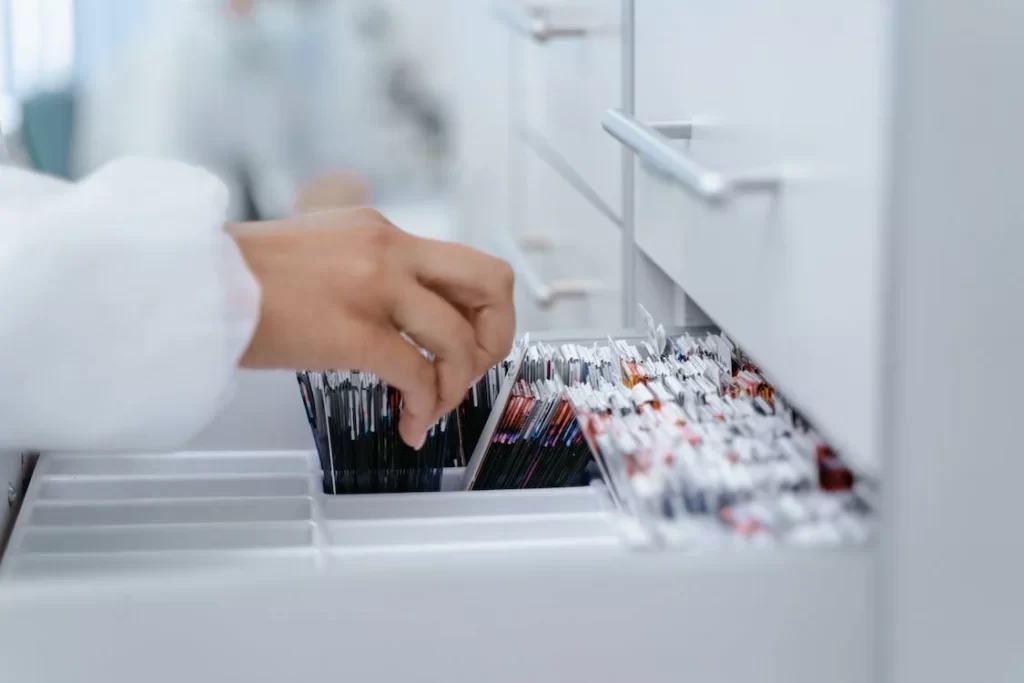The standard operating procedures (SOPs) for storing and transferring COVID-19 samples may differ according on the laboratory or institution, but below are some general suggestions to follow. For processing COVID-19 samples, it is critical to consult with your unique laboratory or institution’s SOPs and local regulations, as there may be additional or more specific requirements.
Equipment and preparation
A viral transfer medium (VTM), swab sticks, ice-box, ice-pads, tongue depressor, marker, requisition form, and personal protective equipment (PPE) are required initially. VTM is a 3 mL fluid containing gelatin and antibacterial agents in a buffered salt solution. It helps to keep the specimen from drying out, keeps the virus alive, and prevents contaminants from spreading. Cotton or calcium alginate swabs should not be used since they may interfere with the PCR process. During sample collection, a stick with a wooden shaft may cause damage. An ice-box and ice-pads are required to maintain the cold chain throughout sample transportation. Before and after usage, the ice pads should be filled with water and stored in the freezer (-20°C). Before beginning the procedure, the requisition form should be completely filled out with patient information, travel history, contact history, and patient and doctor contact numbers. Because sample collection generates aerosols, suitable PPE such as a N95 mask, face shield, gown, goggles, shoe cover, and cap should be used.
Documentation of Sample Movement
It is important to track the movement of biological samples (PCR Samples) from the point of collection from the donor, during processing, storage, distribution and/or use, and disposal. The time and date of collection should be recorded on the Case Report Form; the time the samples are received in the laboratory and the time of testing would be recorded by the laboratory. All samples that are to be stored prior to shipment to an off-site laboratory or another location must be stored under acceptable conditions, and a log of the stored samples must be kept (e.g., a freezer or refrigeration log).
Collection and handling of samples
The collection and processing of samples requires acquiring a representative sample from a population and ensuring that it is treated properly to retain its integrity. To avoid contamination or degradation of the material, proper collecting techniques and storage conditions are required. To achieve accurate results, samples must be accurately labeled and sent to the laboratory on time. Standard operating procedures and safety requirements should be followed throughout the process.
- A sampling plan should be developed to ensure the representative sampling of the population. This includes determining the sampling location, number of samples to be collected, and sampling frequency.
- Samples should be collected using appropriate techniques to prevent contamination and ensure a representative sample. This may involve using a sterile sampling tool, avoiding contact with hands, and avoiding cross-contamination.
- Samples should be stored under appropriate conditions to prevent degradation or contamination. This may include storing samples at a specific temperature, pH, or in a specific preservative.
- Each sample should be labeled with unique identifiers, including the date and time of collection, location, and any relevant information about the sample.
- Samples should be transported to the laboratory in a timely manner and under appropriate conditions to prevent any changes to the sample before analysis.
- Safety guidelines should be followed during sample collection and handling to prevent injury to the person collecting the sample and prevent contamination of the sample. This may include the use of personal protective equipment, proper disposal of waste, and appropriate handling of hazardous material
- Ensure that the immediate sample handling, immediately place on ice and registered in the record. After the proper recording, the sample will be transfer to the laboratory section with respective SID and records for the further procedures.
Specimen packaging
The sample should be safely packed in a three-layer triple-packing technique. The plastic pouch that came with the VTM can be utilized for the first layer. The designated VTM should be placed into the pouch and sealed with adhesive tape. If the cover is not available, a small zip-lock bag should be utilized. The packed VTM should be placed inside another zip-lock bag as the second layer. Finally, the package should be placed in a robust, unbreakable, leak-proof exterior container that serves as the third layer. The VTM, zip-lock bag, and exterior container must all be correctly labeled.
Similarly, the serum sample will be placed in a separate zip-lock bag that will be labeled appropriately.
Disinfect the package with an adequate disinfectant before and after shipping, according to the manufacturer’s instructions, to minimize any potential virus contamination. Transport the item carefully to the laboratory, taking care to avoid any rapid movements or temperature changes that may harm the quality of the sample.
Specimen transportation
The specimen should be transported to the laboratory while maintaining a cold chain (2-4°C). The packaged specimen should be placed within the ice-box, with two ice-pads on either side of the container. The ice-box should be properly cleaned outside with 1% sodium hypochlorite and moved to the laboratory as soon as possible. If the delay exceeds 72 hours, the sample should be stored at -70°C. Separate specimen data forms, letters, and other types of information that identify or describe the specimen for SARS-COV-2 testing should be carried. Include any appropriate documentation, such as a chain of responsibility form or other paperwork, with the sample to track it from collection to analysis. When handling the COVID-19 specimen and transit package, follow applicable safety rules, such as wearing personal protective equipment (PPE).
Specimen storage
Coronavirus specimens should be kept at -70°C or lower to ensure viability for laboratory examination. To prevent the danger of infection, basic safety standards for handling and transporting specimens must also be followed. Specimens can be stored at +2 °C to +8 °C for up to 72 hours after collection. If a delay in extraction is expected, store specimens at -70 °C or lower. Additionally, the separated serum from collected blood sample will be stored in (-80°C).

